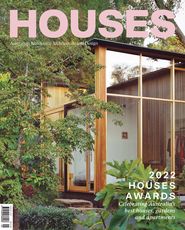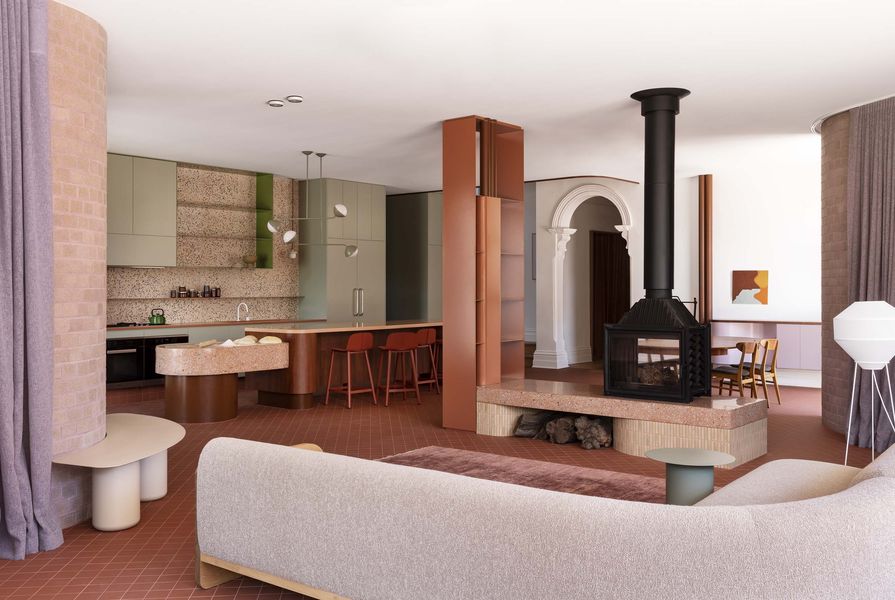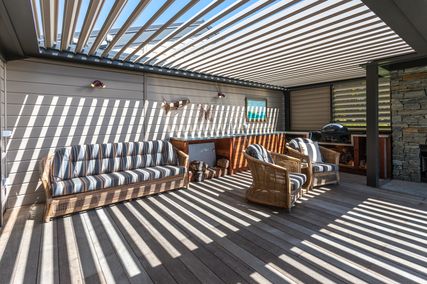“I’m beyond happy!” says Jo, the client for Hermon, as she shows me around Wowowa’s transformation of a substantial Edwardian villa in the inner Melbourne suburb of Hawthorn. It’s what every architect wants to hear, particularly about a project that exemplifies the ethos of their practice. Hermon is not only a lush exercise in Wowowa’s “seriously playful architecture” but, beyond its signature stylishness, it’s a significant contribution to the debate about how we handle the architectural fabric of our suburbs, sustainably.
The leafy inner suburbs of most Australian cities are full of quality nineteenth- and early-twentieth-century building stock. Much of it has been altered or extended in a kind of “mock heritage” style that, for all its good contextual intentions, is awkward visually and functionally. While Hermon fitted this pattern, it was solidly and thoughtfully built, with a 1990s “pop-top” to the original 1906 structure that respected the existing roof form and materials. Paradoxically, with no heritage overlays to the house it would have been straightforward to demolish and start from scratch, but both Wowowa and the clients reject such needless waste. Instead, they sought ways to retain and reinvent the house to respond to changing domestic demands – a family with teenage boys, working-from-home routines and potential multigenerational accommodation. Practice principal Monique Woodward describes the task as “the ultimate radical postmodern challenge – to land three styles at once,” and Wowowa’s solution as a “soup of Edwardian, diligent faux and new robust contemporary.”
If the rapport evident between architect and client is anything to go by, Wowowa met the challenge comprehensively. “I did my homework choosing our architect,” says Jo, who was attracted to the predominantly female team of Wowowa. With her strong interest in social justice, she was attracted to the emphasis Wowowa places on gender equity across its projects and its workplace. It was a priority that the architects she would work with understood and embraced the natural chaos of family life. As I chat with Jo and Monique at the kitchen bench, surrounded by school cupcakes, a stray balloon, and the odd chook within cooee, the project feels relaxed, welcoming and, in Monique’s words, “somehow Australian.”
A key tactic was integrating interior and exterior space by carving out the ground floor to only what was needed, and getting the levels right at the outdoor junctions. Externally, this makes an easy sequence of terraces, with a quirky built-umbrella structure extending into the garden; internally, it allows a seamless flow for busy family life.
Removing the “scar tissue” of the previous alteration opens up a main space for living, cooking and dining. Defined by curved walls, expressed steel structure, shelves, hearth and kitchen bench, it is “about being at once separate and together,” just as the clever handling of floor and ceiling junctions with the original house allow the old and new to coexist sympathetically.
The generous scale of the original house informs other strategies. A quarter of the original core is reworked to yield “his and hers” studies, a small bathroom, a storage wall, and a lift theatrically concealed behind a sweep of curtain. Like the service wing of butler’s pantry, store and laundry, it is an intensely useful zone, striking in colour and material yet sensitively tied to the proportions and datums of the original house.
The same principles have been applied in the modification of the upstairs nineties expansion: vertical connection is refreshed with confident steel detailing to the existing staircase, and a perky, mesh-enclosed attic stair draws on Wowowa’s expertise in school projects. Deepened thresholds and door linings thicken the upper-floor construction in subtle reference to the substantial quality of Hermon’s Edwardian foundations.
Joinery is a major component of Wowowa’s architectural intervention, adding colour, texture and an enviable amount of storage. Monique explains that “we were kind of Tim Tam-ing with the colour scheme,” one of many gastronomic references she makes to the home’s luscious palette. This is characteristic of Wowowa’s work, which the practice happily describes as “lickable,” “yummy” or inspired by Australiana like the Women’s Weekly Cookbook . This degree of colour and material courage is rare in contemporary residential work, and though Monique attributes it in part to the colourful suburban houses of her regional childhood, it has become a refined, contextual strategy. At Hermon, the prompts start with the original architecture – sanguine brickwork, grey bluestone, front door leadlight of lilacs and greens – and translate in inventive ways: rust colour-blocking exterior detailing, concrete masonry with lilac mortar and a sequence of migrating hues across paving, terrazzo, joinery and paint finishes. I count three shades of green in the kitchen alone.
Wowowa’s website is joyful, playful, plentiful, colourful – many “fuls” apply to the practice’s approach. There’s a knowing nod to the excesses of postmodernism in their ebullient design language, but it isn’t at the expense of rationality or environmental responsibility. Unafraid of “style,” they nevertheless prioritize “substance,” whether through the discreet incorporation of solar panels and batteries in the new garage-studio, or the functional and experiential opportunities for every element to become somehow “more than.” Monique sums it up: “I love the concept of ‘and’ – it’s a wall and … ; it’s a fireplace and … – rather than ‘but’ or ‘or’.” It’s no doubt what every client wants to hear, but it also encapsulates our bigger responsibility to the global management of limited resources. Wowowa’s ability to bring delight to that serious task is as idiosyncratic as Iced Vovos, and in a house that so neatly matches its inhabitants, it’s the icing on the cake.
Products and materials
- Roofing
- Junglefy pebble ballast and garden; Lysaght Spandek cladding in Colorbond ‘Terrain’.
- External walls
- Simmental Silver’ Bowral bricks from Austral Bricks; combed stucco render; ASH Iron Ash shiplap.
- Internal walls
- ‘Simmental Silver’ Bowral bricks from Austral Bricks; Cedar Sales linings; Colori tiles from Tiento in ‘Mela,’ ‘Indaco’ and ‘Baia’.
- Windows
- KDHW timber frames by Future Windows.
- Doors
- Ventech veneers in ‘Ironbark’ quarter; KDHW timber frames by Future Windows.
- Flooring
- Metro Mix custom- colour concrete; Colori tiles from Tiento in ‘Gres’.
- Lighting
- Brightgreen downlights; RBW wall lights from Koda; Coco Flip pendants
- Kitchen
- Astra Walker tapware in ‘Satin Nickel’; stainless steel sinks from ABI; Miele and Fisher and Paykel appliances; Zip tap in ‘Satin Nickel’; Heatlie stainless steel barbecue; Kaza backsplash tiles from Academy Tiles.
- Bathroom
- Astra Walker tapware in ‘Satin Nickel’; basins from ABI; terrazzo slab from Signorino; Ventech veneers in ‘Ironbark’.
- Heating and cooling
- Underfloor hydronic emission plate; Siena fireplace by Living Fire.
- External elements
- Bega external downlights; Colori tiles from Tiento in ‘Gres’; Metro Mix concrete; Unearthed Landscapes concrete tile.
- Other
- Jardan and Coco Flip furniture; custom hearth with top by Metro Mix and Mini Iriede tiles from Academy Tiles.
Credits
- Project
- Hermon
- Architect
- Wowowa Architecture
Melbourne, Vic, Australia
- Project Team
- Monique Woodward, Jean-Marie Spencer
- Consultants
-
Builder
Basis Builders
Engineer R. Bliem and Associates
Interiors Wowowa Architecture
Joinery Evolve Interiors
Landscaping Amanda Oliver
Stylist Ruth Welsby
- Aboriginal Nation
- Hermon is built on the land of Wurundjeri Woi Wurrung people of the Kulin nation.
- Site Details
-
Location
Melbourne,
Vic,
Australia
Site type Suburban
Site area 1495 m2
Building area 476 m2
- Project Details
-
Status
Built
Design, documentation 6 months
Construction 15 months
Category Residential
Type Alts and adds
Source

Project
Published online: 26 Aug 2022
Words:
Rachel Hurst
Images:
Martina Gemmola
Issue
Houses, August 2022





















